Birds are some of the most fascinating creatures in nature. Dedza, a district in the Central Region of Malawi, has an astonishing variety of birdlife. There is something for everyone, from the colorful and vocal weavers to the majestic crowned eagles.
Bird watching is a popular activity in Dedza, as the area is home to a diverse range of species, both resident and migratory. Visitors to the area can enjoy a variety of bird-watching experiences, from small woodland birds to large raptors and waterfowl.
Dedza is a great place to experience the beauty and diversity of nature, and its birds are an essential part of this.
24 Birds to Watch in Dedza
Dedza is a district in the Central Region of Malawi, a paradise for bird lovers. The area boasts diverse birdlife, from colorful songbirds to majestic raptors. Whether a beginner or an expert, you will find something to delight you in Dedza.
Here are 24 birds you should not miss when visiting this fantastic place.
1. White-faced Whistling Duck
The white-faced whistling duck is a species of whistling duck mainly found in sub-Saharan Africa and South America. It is a social bird that enjoys being around other birds.
It is not unusual to see large flocks of these ducks numbering up to one thousand birds, especially at specific favored sites.
These flocks typically assemble at dawn, which can be a truly awe-inspiring sight to behold. The white-faced whistling duck is a unique species with several defining characteristics. The most prominent of these is its white face, starkly contrasting its dark body.
Additionally, the white-faced whistling duck is unique among its species for its impressive ability to make a loud whistling sound.
This sound is often used to communicate with other species members, whether a warning of danger or a call to assemble. The white-faced whistling duck is a species that enjoys living and breeding in wetland areas.
This species can find adequate food sources such as aquatic plants, insects, and small fish.
This species can also find shelter in trees and other vegetation near wetlands. In conclusion, the white-faced whistling duck is a unique species often found in large flocks.
This species can make a loud whistling sound and can be found in wetland areas. Seeing a thousand of these ducks arriving at dawn is genuinely unique and awe-inspiring.
| Kingdom | Animalia |
| Phylum | Chordata |
| Class | Aves |
| Order | Anseriformes |
| Family | Anatidae |
| Genus | Dendrocygna |
| Species | D. viduata |
2. Cuckoos
Cuckoos are a family of birds belonging to the Cuculidae family, the only taxon in the order Cuculiformes. The cuckoo family includes many species, such as the standard or European cuckoo, roadrunners, koels, malkohas, couas, coucals, and anis.
The coucals and anis are sometimes designated as separate families, known as the Centropodidae and Crotophagidae. Cuckoos are found worldwide, and their habitats range from wetlands and forests to desert areas.
They are known for their distinctive calls, which vary between species. Cuckoos feed on a variety of invertebrates, as well as small mammals and birds.
They are also renowned for their ability to lay eggs in another bird’s nest, and this trait has earned them the name of ‘brood parasites.”
| Kingdom | Animalia |
| Phylum | Chordata |
| Class | Aves |
| Clade | Otidimorphae |
| Order | Cuculiformes |
| Family | Cuculidae |
3. Fulvous Whistling Duck
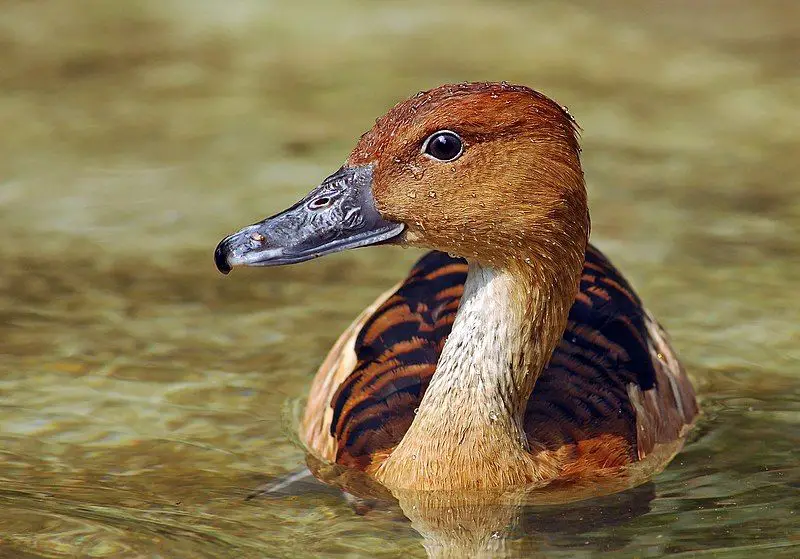
The Fulvous Whistling Duck, also known as the Fulvous Tree Duck, is a globally distributed species of whistling duck. It breeds in many regions across the tropics, including Mexico and South America, the West Indies, the southern United States, and parts of Africa and India.
It is found in many habitats, including wetlands, open woodlands, and agricultural areas. The Fulvous Whistling Duck is a medium-sized duck with a long neck and a long, pointed bill. It has a brown head, neck, and breast, with a light buff-colored belly.
Its back and wings are mottled grayish-brown. The Fulvous Whistling Duck is a highly social species and often forms large flocks. Its call is a distinctive, high-pitched “whistling” sound, similar to a teal or pintail duck.
This omnivorous species feeds on various aquatic plants, seeds, grains, and insects. The Fulvous Whistling Duck is an integral part of many of the world’s wetlands and a valuable resource for local communities.
| Kingdom | Animalia |
| Phylum | Chordata |
| Class | Aves |
| Order | Anseriformes |
| Family | Anatidae |
| Genus | Dendrocygna |
| Species | D. bicolor |
4. Senegal Coucal
The Senegal coucal is a species of bird belonging to the Cuculiformes order, which also includes other birds such as roadrunners, anis, and hoatzins.
It is a medium-sized bird typically found in lightly wooded habitats such as savannahs in central and southern Africa.
This species is part of the same genus as other coucals but is in a much more limited area. The Senegal coucal is a unique bird species with a few physical characteristics that distinguish it from other members of its genus.
It has a thick, heavily feathered body, and its wings are relatively short, giving it a more compact appearance. Its legs are long and robust, with a long, curved bill.
Its coloration is mostly brownish-black, with buff-colored feathers on the upper parts of its body. The Senegal coucal is an omnivorous bird that feeds on various insects, fruits, and small animals.
They are usually found in pairs or small groups and are generally non-migratory. They are known to be territorial and can become quite vocal when defending their territory. Regarding conservation, the Senegal council is listed as a species of Least Concern by the IUCN.
While their population is decreasing, their range is still extensive, and their habitats remain relatively intact. However, they are threatened by habitat destruction, hunting, and trapping, and conservation efforts are necessary to ensure their survival.
| Kingdom | Animalia |
| Phylum | Chordata |
| Class | Aves |
| Order | Cuculiformes |
| Family | Cuculidae |
| Genus | Centropus |
| Species | C. senegalensis |
5. African Palm Swift
The African palm swift is a bird species in the swift family, found in most sub-Saharan Africa. It is a small bird with brown-grey feathers similar to the Asian palm swift, Cypsiurus balasiensis.
The two species were considered the same at one point, but they have since been classified as separate species. Recently, a third species, the Malagasy palm swift, has been identified as separate from the African and Asian palm swifts.
This species is found in Madagascar and has a distinct plumage and vocalization compared to the other two species. All three species are closely related and can be found in tropical forests and woodlands.
They feed mainly on insects caught in flight and breed in hollow trees, often nesting in the same tree as other swifts.
| Kingdom | Animalia |
| Phylum | Chordata |
| Class | Aves |
| Clade | Strisores |
| Order | Apodiformes |
| Family | Apodidae |
| Genus | Cypsiurus |
| Species | C. parvus |
6. Emerald-spotted Wood Dove
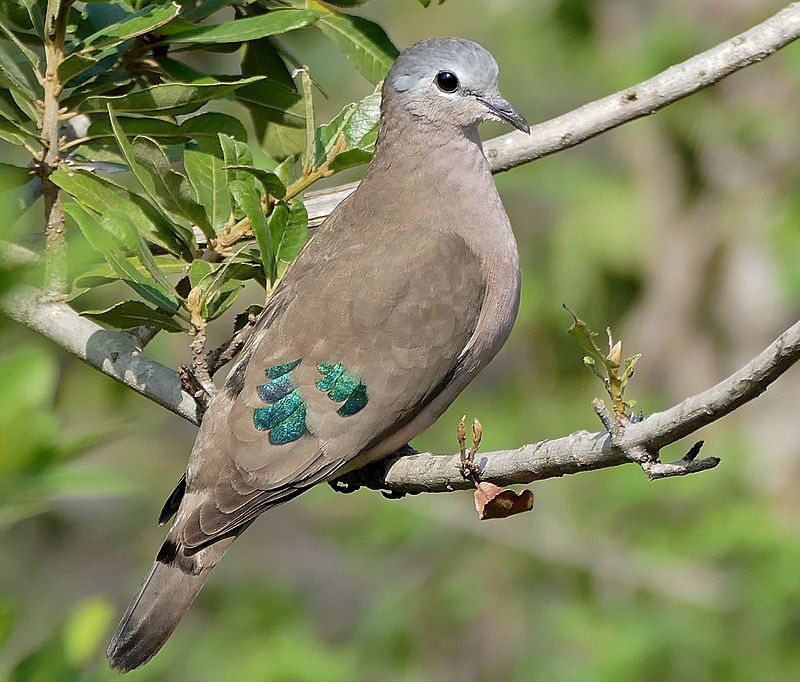
The emerald-spotted wood dove is a species of bird that belongs to the family Columbidae and is found throughout eastern and southern Africa.
They are commonly seen in drier, deciduous woodlands and other regrowth areas but do not inhabit evergreen rainforests or semi-desert regions. The emerald-spotted wood dove is an attractive bird species with distinctive emerald-colored spots on its wings and head.
It is usually found in flocks of up to twenty birds, and they are often seen perched on branches or foraging in open grassy areas.
As the birds are not adapted to wetter areas, they are absent from evergreen rainforests and semi-desert regions. The emerald-spotted wood dove feeds on seeds, grains, and small insects and is usually seen foraging during the morning and evening.
The bird builds its nests in loose colonies, often in the branches of trees, and the female will lay two or three eggs.
Both parents feed the chicks, and they usually fledge within two weeks. The emerald-spotted wood dove is an interesting bird species, adapted to living in drier, deciduous woodlands and other open habitats.
They are absent from these areas because they cannot survive in evergreen rainforests or semi-desert regions. This is important to note as it helps us understand the distribution of this bird species and allows us to protect its habitat.
| Kingdom | Animalia |
| Phylum | Chordata |
| Class | Aves |
| Order | Columbiformes |
| Family | Columbidae |
| Genus | Turtur |
| Species | T. chalcospilos |
7. Red-eyed Dove
The red-eyed dove is a species of bird found throughout Sub-Saharan Africa. It is a widely distributed bird and is a common sight in many parts of the continent.
The International Union for Conservation of Nature (IUCN) has classified the red-eyed dove as a species of “Least Concern” since 2004.
This means the species is not threatened with extinction and is considered relatively widespread.
The red-eyed dove is a medium-sized bird, typically measuring between 25 and 30 centimeters in length, with a wingspan of 40 to 45 centimeters. Its plumage is gray-brown overall, with darker markings on its wings and tail.
As its name suggests, the red-eyed dove has bright red eyes, and its beak is pinkish-orange. The red-eyed dove is usually found in small flocks and is typically seen foraging for food on the ground. It feeds on small insects, seeds, and fruits.
| Kingdom | Animalia |
| Phylum | Chordata |
| Class | Aves |
| Order | Columbiformes |
| Family | Columbidae |
| Genus | Streptopelia |
| Species | S. semitorquata |
8. Ring-necked Dove
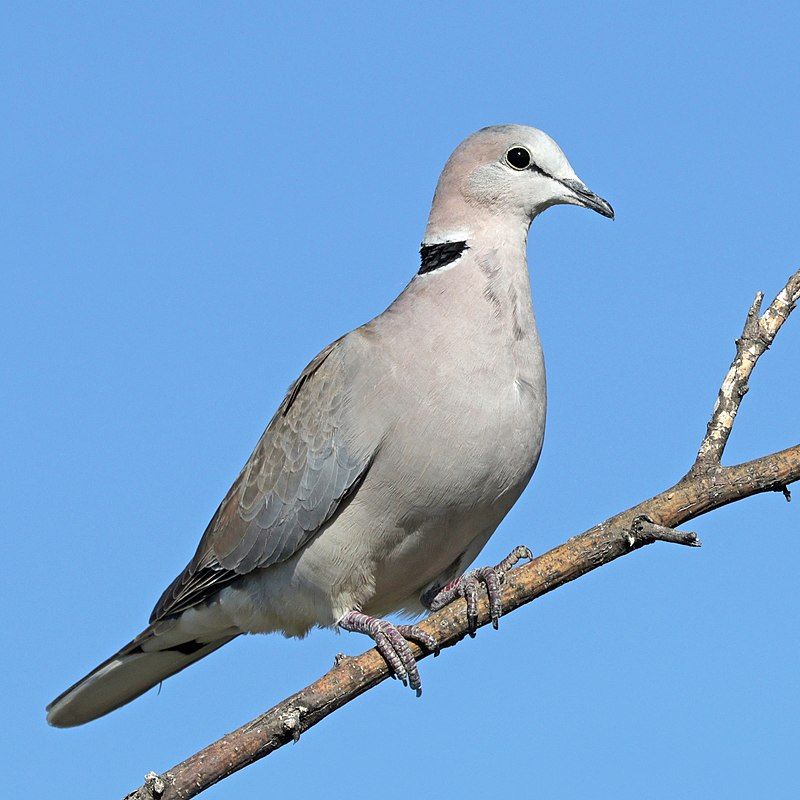
The ring-necked dove is a species of dove found in East and southern Africa. It has several names, including the Cape turtle and half-collared dove, making it a widely recognized bird.
The ring-necked dove is mainly a sedentary species, meaning it does not migrate but stays in its native area. This species inhabits various open habitats, such as grasslands, agricultural fields, and woodlands.
Its diet consists of seeds and grains, which it obtains from the ground. It can also be seen in drinking water from puddles and other water sources. The ring-necked dove is often abundant in its range and can form large flocks when foraging for food.
Its beautiful coloring and its melodious song make it a favorite amongst birdwatchers.
| Kingdom | Animalia |
| Phylum | Chordata |
| Class | Aves |
| Order | Columbiformes |
| Family | Columbidae |
| Genus | Streptopelia |
| Species | S. capicola |
9. White-browed Coucal
The white-browed coucal, also known as the lark-heeled cuckoo, is a species of cuckoo in the family Cuculidae. It is native to sub-Saharan Africa and is found in thick vegetation and scrub, including in some coastal regions.
Burchell’s coucal is sometimes considered a subspecies of the white-browed coucal, though this is not universally accepted. The white-browed coucal is a medium-sized bird, typically measuring around 33 cm long.
Its plumage is mainly brownish-black, with a white throat and eyebrows, giving it its name. It has a long, broad tail and typically forages on the ground for food.
The white-browed coucal is usually solitary but may be seen in pairs or small groups during the breeding season. Its diet consists mainly of insects, although it may also take some small reptiles, amphibians, and other small animals.
It is an opportunistic feeder and will take advantage of available food sources. Its call is a loud, metallic ‘kook-kook-kook,’ often heard during the day.
| Kingdom | Animalia |
| Phylum | Chordata |
| Class | Aves |
| Order | Cuculiformes |
| Family | Cuculidae |
| Genus | Centropus |
| Species | C. superciliosus |
10. Crested Francolin
The crested francolin is a species of bird native to southern Africa belonging to the family Phasianidae. It is a large, ground-dwelling bird, typically measuring up to 46 cm in length, and has a 60-70 cm wingspan.
It is primarily brown, with a black head and neck, a white eyebrow-like crest, a white throat, and a black-barred white chest.
Its call is a loud, high-pitched whistle. The crested francolin has several subspecies, one being Ortygornis sephaena ovum or Kirk’s francolin.
It is distinguished by its darker plumage, a white breast instead of a black-barred one, and a different call than the crested francolin. While some experts consider it a separate species, others have argued that it is merely a subspecies of the original.
| Kingdom | Animalia |
| Phylum | Chordata |
| Class | Aves |
| Order | Galliformes |
| Family | Phasianidae |
| Genus | Ortygornis |
| Species | O. sephaena |
11. Greater Flamingo
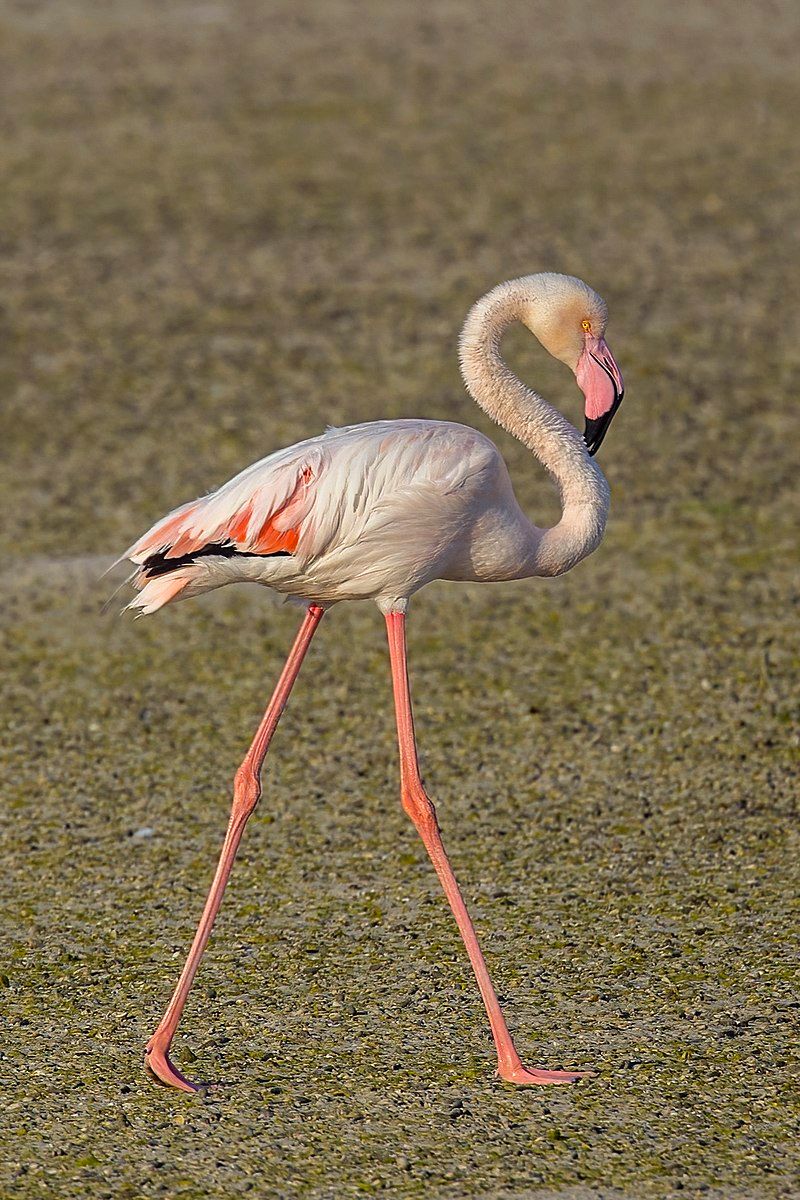
The greater flamingo is the most widespread and significant species of the family. Found across the Old World, they can be seen in a variety of climates and habitats.
These birds are found in large numbers in Northern and Sub-Saharan Africa, the Indian Subcontinent, the Middle East, the Levant, the Persian Gulf, the Gulf of Aden, the Red Sea, and the Mediterranean countries of Southern Europe.
These flamingos are found near freshwater and saltwater bodies, such as lakes, lagoons, swamps, marshes, and estuaries.
They congregate in thousands of individual flocks and feed on shrimp, fish, mollusks, and algae. The greater flamingo stands out from other species of flamingos due to its size and color.
It stands between 3.9 and 4.7 feet tall and has a wingspan of around 5.9 feet.
Its feathers are generally white, but it has a distinctive bright pink or orange hue on the head, neck, and chest. The greater flamingo is an iconic species, and its presence signifies a healthy wetland ecosystem.
They often act as keystone species, playing a crucial role in the food web by consuming large amounts of small invertebrates and providing food for larger predators. In addition, their droppings help fertilize the wetlands, increasing the area’s productivity.
| Kingdom | Animalia |
| Phylum | Chordata |
| Class | Aves |
| Order | Phoenicopteriformes |
| Family | Phoenicopteridae |
| Genus | Phoenicopterus |
| Species | P. roseus |
12. Helmeted Guineafowl
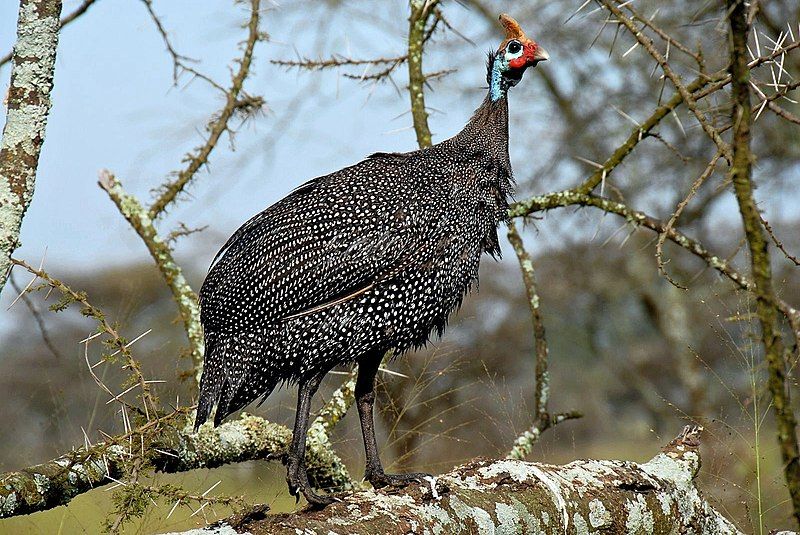
The helmeted guineafowl is a species of bird that is part of the Numididae family and is the only member of the genus Numida.
It is native to Africa, primarily south of the Sahara Desert. It has also been introduced to other parts of the world, such as the West Indies, North America, Colombia, Brazil, Australia, and Europe.
This introduction was intentional, as people have domesticated the helmeted guineafowl for various reasons. The helmeted guineafowl is characterized by its distinctive helmet-like crest, which gives it its name.
The bird is usually grey or black and typically seen in small flocks. It feeds mainly on insects, small reptiles, and some plants.
In addition to being domesticated for its meat, the helmeted guineafowl has been kept as pets or for its ornamental value. The helmeted guineafowl is a hardy species well-adapted to survive in various habitats.
It is found in grasslands, shrublands, woodlands, and even farmland.
It is also known to be a very vocal species, and its loud, raucous call is often heard in the African bush. Overall, the helmeted guineafowl is a species that is well-known and widespread across the African continent and beyond.
It is a widespread species among birders and other wildlife enthusiasts, and it’s colorful appearance and unique call make it an iconic species in its natural range.
| Kingdom | Animalia |
| Phylum | Chordata |
| Class | Aves |
| Order | Galliformes |
| Family | Numididae |
| Genus | Numida |
| Species | N. meleagris |
13. Pennant-winged Nightjar
The pennant-winged nightjar is a bird species found in an area stretching from Nigeria to northern South Africa. It is a migratory species that will travel between the two regions for breeding.
During the breeding season, the nightjar displays a striking sexual dimorphism, with the sexes looking significantly different. Males have a distinct white and black pattern on their wings, while females are generally more brown.
This dimorphism is thought to be an adaptation for avoiding predation, as the two sexes can blend into their respective environments. In addition, the more colorful males can attract mates with their bright plumage.
The pennant-winged nightjar is an essential species in the African ecosystem, and its unique habits make it an interesting species to study.
| Kingdom | Animalia |
| Phylum | Chordata |
| Class | Aves |
| Clade | Strisores |
| Order | Caprimulgiformes |
| Family | Caprimulgidae |
| Genus | Caprimulgus |
| Species | C. vexillarius |
14. Double-banded Sandgrouse
The double-banded sandgrouse is a species of bird found in arid regions of southern Africa. It is a member of the family Pteroclidae, which consists of predominantly terrestrial birds.
This means that double-banded sandgrouse prefer to live and forage on the ground rather than in trees or other elevated areas. The species is most commonly found in semi-arid, arid, and desert habitats, such as the Kalahari and Namib deserts.
They inhabit areas with sparse vegetation, where they can forage for food and build nests on the ground. The double-banded sandgrouse has evolved to survive in these harsh and unforgiving conditions, with abundant food sources.
They can feed on various seeds, plants, and insects and travel long distances in search of food and water.
This species is also well adapted to the extreme temperatures of the desert, with feathers that insulate them from the heat during the day and keep them warm at night.
To survive in such a harsh environment, the double-banded sandgrouse has developed several unique adaptations that enable it to thrive.
| Kingdom | Animalia |
| Phylum | Chordata |
| Class | Aves |
| Order | Pterocliformes |
| Family | Pteroclidae |
| Genus | Pterocles |
| Species | P. bicinctus |
15. Black-winged Stilt
The black-winged stilt is a species of wading bird found in many parts of the world. It belongs to the family of avocets and stilts and is classified by the scientific name of H. himantopus.
It is characterized by its very long legs, which gives it an advantage when wading through shallow water. As a result, it is widely distributed and can be found in many different habitats.
It has a cosmopolitan range, meaning it can be found in many different locations across the globe. It is a distinctive bird, with its black wings often used to identify it from other species.
The black-winged stilt is an integral part of the ecosystem, as it helps to maintain balance in the food chain by consuming small aquatic creatures. It also helps prevent flooding and soil erosion through its wading activities.
| Kingdom | Animalia |
| Phylum | Chordata |
| Class | Aves |
| Order | Charadriiformes |
| Family | Recurvirostridae |
| Genus | Himantopus |
| Species | H. himantopus |
16. Fiery-necked Nightjar
The fiery-necked nightjar is found in the African continent south of the equator. It belongs to the family Caprimulgidae, which includes around 125 species of nightjars and is known for its distinctive call.
This call is often described as a “good-lord-deliver-us” sound, uttered frequently by the species. The fiery-necked nightjar has a distinct plumage, consisting of a gray-brown head and upper parts, with a pale breast and a bright reddish-orange nape and throat.
The species is also known for its yellow eyes and its dark tail. The fiery-necked nightjar is a nocturnal bird, usually found singly or in pairs in woodland, shrubland, and savannah habitats.
The species feeds on insects and other invertebrates, which it catches in flight and is known to be active at night. The call of the fiery-necked nightjar is a distinct sound consisting of a single note repeated several times.
The sound is often described as a “good-lord-deliver-us” call, unique to this species.
This call is uttered frequently by the species and is used to attract mates and establish territory. The fiery-necked nightjar is an essential species in its native range, as it is a part of the food web and a beneficial predator.
The species is susceptible to habitat destruction, which can lead to a decrease in the population. Conservation efforts such as habitat protection are necessary to ensure the species’ survival.
| Kingdom | Animalia |
| Phylum | Chordata |
| Class | Aves |
| Clade | Strisores |
| Order | Caprimulgiformes |
| Family | Caprimulgidae |
| Genus | Caprimulgus |
| Species | C. pectoralis |
17. Garganey
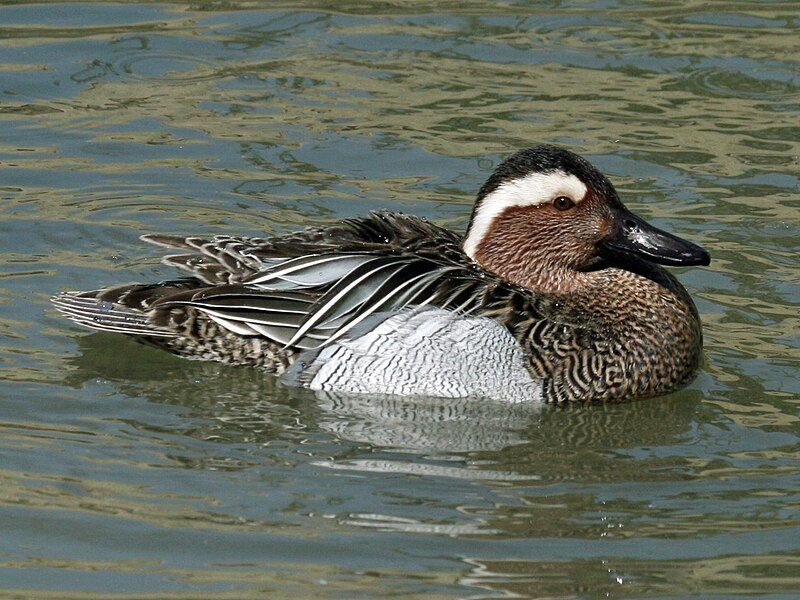
The garganey is a species of small dabbling duck found across much of Europe and the Palearctic region. It is a migratory bird that moves to different locations depending on the season.
During the winter of the Northern Hemisphere, the entire population of garganeys flies south to places such as southern Africa, India, Bangladesh, and Australasia. Once there, they form large flocks that can be observed in these regions.
During the summer, the garganeys return to their breeding grounds in the Northern Hemisphere. This cycle is repeated every year, allowing the population of garganeys to remain strong and healthy.
| Kingdom | Animalia |
| Phylum | Chordata |
| Class | Aves |
| Order | Anseriformes |
| Family | Anatidae |
| Genus | Spatula |
| Species | S. querquedula |
18. Guineafowls
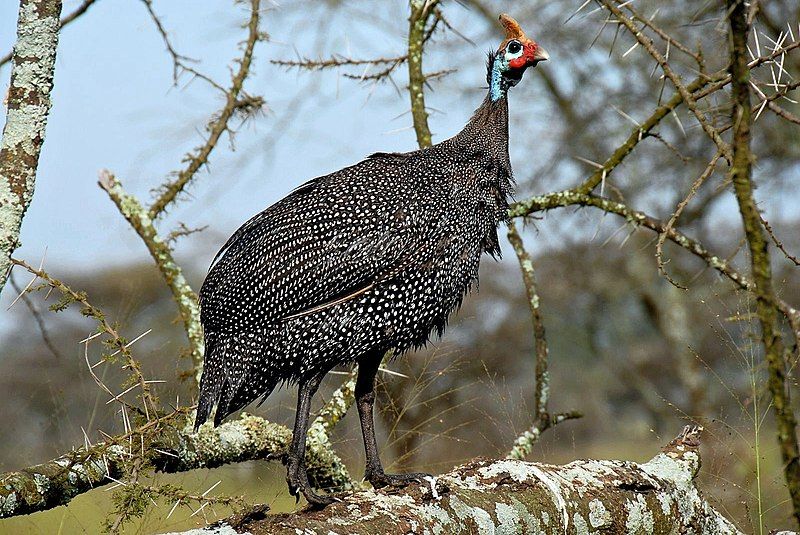
Guineafowl are a bird that belongs to the family Numididae and the order Galliformes. They are native to Africa and have been around for a long time. Phylogenetically, they are related to other Galliformes, which include the Cracidae and the Odontophoridae.
Guineafowl are considered “core” Galliformes, meaning they are more closely related to the other Galliformes than any other species. This makes them an essential part of the evolutionary history of the Galliformes.
Guineafowl have been around for millions of years and evolved into the species we see today. They are an essential part of the African avian fauna and are a vital link in the evolutionary chain of the Galliformes.
| Kingdom | Animalia |
| Phylum | Chordata |
| Class | Aves |
| Order | Galliformes |
| Family | Numididae |
19. Great Cormorant
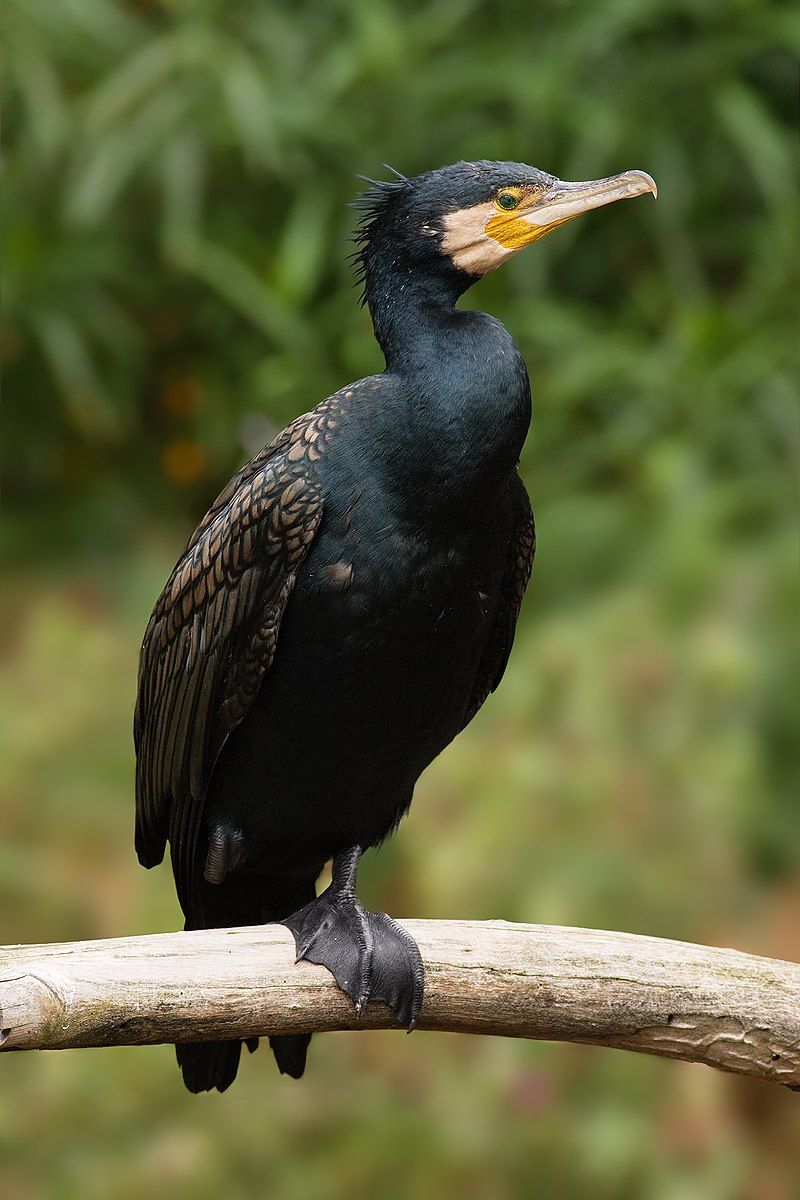
The great cormorant is a seabird species found across the Northern Hemisphere, Australia, and India. Different names in different countries know it.
In New Zealand, it is called the black shag or kawau, while in the Northern Hemisphere, it is known as the great black cormorant. In Australia, it is called the black cormorant; in India, it is known as the large cormorant.
This seabird species is prevalent and can be found in various habitats, from coastal areas to inland lakes and rivers. The great cormorant is a large seabird with a wingspan of up to 1.8 m.
Its plumage is primarily black, with white patches on the neck and underparts. It feeds mainly on fish, which it dives for, and it can dive up to depths of 10 m in search of prey.
It nests in colonies, often on cliffs or coastal islands, and the female lays up to four eggs, which both parents incubate. The great cormorant is an important species for many coastal communities, as it helps control the fish population.
It is also a famous bird for birdwatchers, who often seek out its spectacular displays of aerial acrobatics.
Despite its widespread distribution, the great cormorant is classified as a species of ‘Least Concern’ by the IUCN Red List of Threatened Species due to its large population and wide range.
| Kingdom | Animalia |
| Phylum | Chordata |
| Class | Aves |
| Order | Suliformes |
| Family | Phalacrocoracidae |
| Genus | Phalacrocorax |
| Species | P. carbo |
20. Little Grebe
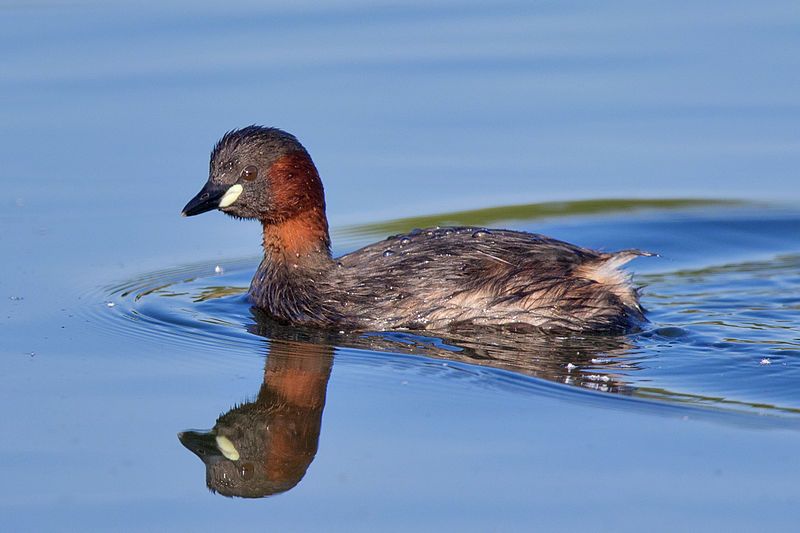
The little grebe, also known as dabchick, is a small water bird belonging to the family of grebes. Its scientific name, Tachybaptus ruficollis, is derived from Ancient Greek and Latin.
The genus name, Tachybaptus, is derived from the Greek words takhus, meaning “fast,” and bapto, meaning “to sink under,” suggesting the bird’s swift diving abilities.
The specific name, ruficollis, is derived from the Latin Rufus, meaning “red,” and Modern Latin -collis, “-necked,” which comes from the Latin word collum, meaning “neck.” The red-necked little grebe is thus easily identified by its reddish-brown neck.
| Kingdom | Animalia |
| Phylum | Chordata |
| Class | Aves |
| Order | Podicipediformes |
| Family | Podicipedidae |
| Genus | Tachybaptus |
| Species | T. ruficollis |
21. Speckled Mousebird
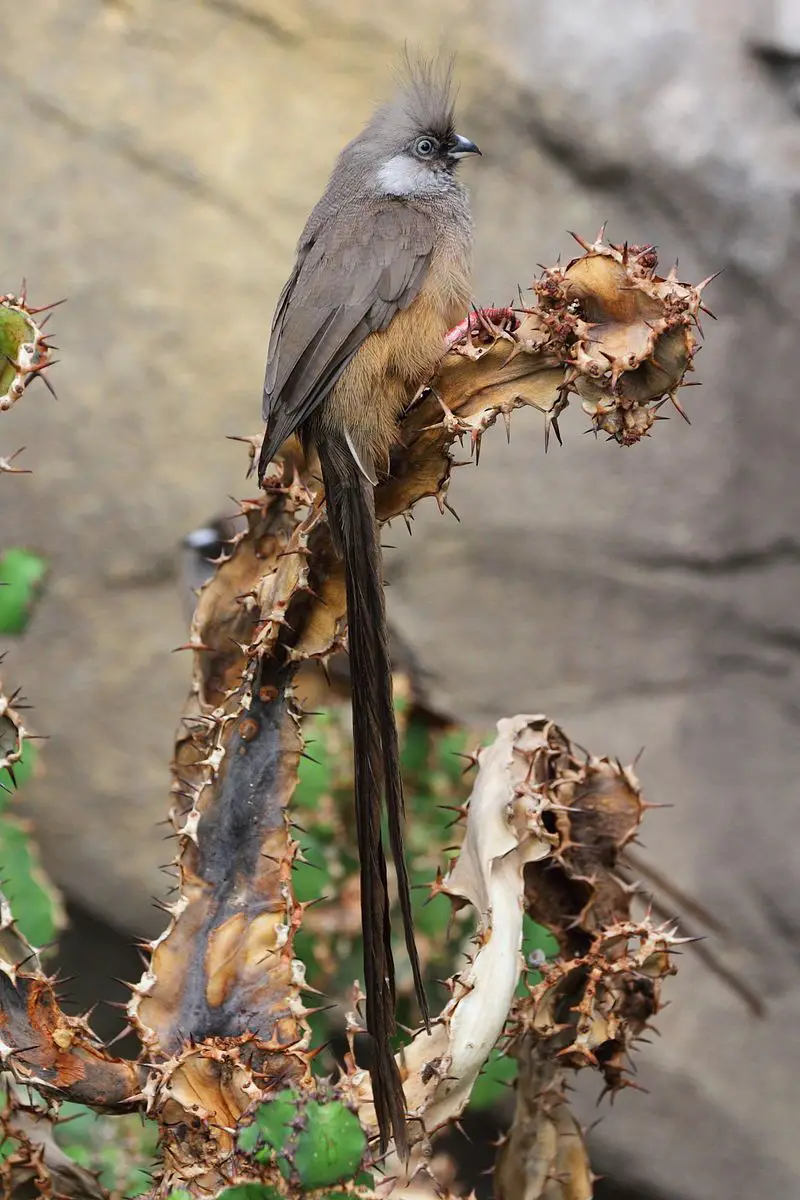
The speckled mousebird is a large species throughout Central, Eastern, and Southern Africa. These birds are common and can be seen in many habitats, from open woodlands to savannas.
They are small, just about 9 inches long, but they can fly long distances. The speckled mousebird has a distinctive plumage, with its head and back light grey and its wings and tail darker grey.
Its chest and belly are bright white, and its wings have a black line on the underside. It also has a black line around its eyes and a red patch on its throat. The speckled mousebird is an omnivore, feeding on various fruits, seeds, insects, and even small vertebrates.
They are usually seen in small flocks and are pretty social, often perching together and preening on each other. They have a distinctive call and can be heard from a distance.
Overall, the speckled mousebird is a fascinating species and ubiquitous sight throughout Central, Eastern, and Southern Africa.
| Kingdom | Animalia |
| Phylum | Chordata |
| Class | Aves |
| Order | Coliiformes |
| Family | Coliidae |
| Genus | Colius |
| Species | C. striatus |
22. Freckled Nightjar
The Freckled Nightjar, also known as the Freckled Rock Nightjar, is a bird species in the Caprimulgidae family. It has a broad yet patchy distribution, meaning it can be found in many different places but not all.
This nightjar species is mainly found in the Afrotropics, the tropical region of Africa. The Freckled Nightjar is a small bird, usually brown or gray, with spotted markings on its feathers. Its wings are long and pointed, and its tail is short and rounded.
Its diet consists mainly of insects, which it catches in flight. It is most active at night when it hunts for food. This species is also known for its loud, repetitive call, which can be heard at night.
The Freckled Nightjar is an integral part of the ecosystem, helping control the populations of specific insect species.
| Kingdom | Animalia |
| Phylum | Chordata |
| Class | Aves |
| Clade | Strisores |
| Order | Caprimulgiformes |
| Family | Caprimulgidae |
| Genus | Caprimulgus |
| Species | C. tristigma |
23. Lesser Jacana
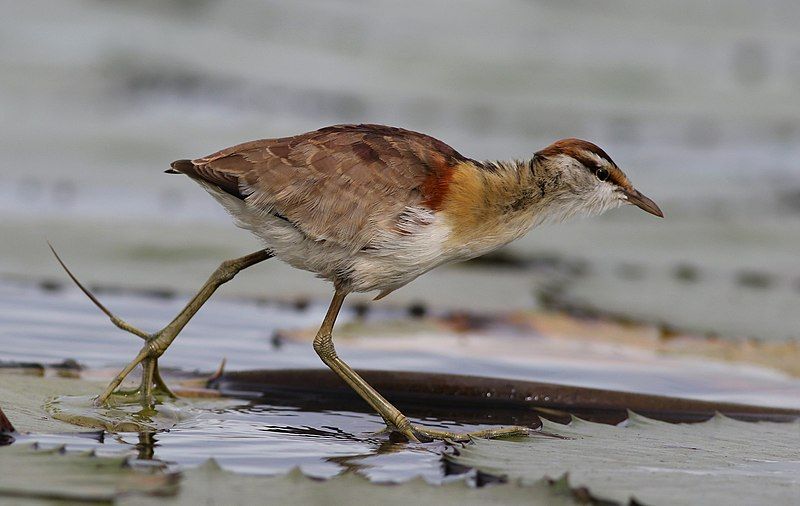
The lesser jacana is a unique species of bird found in the Jacanidae family. It is the only species in the genus Microparra, meaning it does not belong to any other species.
This species is found mainly in South and Southeast Asia, inhabiting wetlands and shallow lakes. These birds have a distinctive appearance, with bright yellow legs and a black crest.
A large yellow wing patch also characterizes them, while their bodies are black and white. The lesser jacana has a powerful beak used for foraging in shallow waters, mainly feeding on insects, small fish, and aquatic plants.
Their breeding season is usually during summer when they build their nests close to the water’s edge. The female is known to lay up to three eggs, which she incubates for three weeks.
The chicks are born precocial, meaning they can leave the nest and feed themselves soon after hatching.
The lesser jacana is considered to be of least concern regarding endangerment. However, its population is still declining due to the loss of wetland habitats and the introduction of predatory species.
Consequently, conservation efforts are essential to ensure the continued survival of this species.
| Kingdom | Animalia |
| Phylum | Chordata |
| Class | Aves |
| Order | Charadriiformes |
| Family | Jacanidae |
| Genus | Microparra |
| Species | M. capensis |
24. African Cuckoo
The African cuckoo is a cuckoo species belonging to the family Cuculidae. It is found in Sub-Saharan Africa, where it migrates within the continent. Generally, it arrives and breeds in any locality during the rainy season.
The African cuckoo is an intrepid traveler, following the rains in its quest for suitable nesting and feeding grounds.
During the dry season, the cuckoo is often seen in open savannas and dry woodlands, where it takes advantage of the abundant insects and small vertebrates available in these areas.
During the rainy season, the cuckoo migrates to wetter localities, such as riversides, marshes, and flooded areas, where it can feed on larger prey, such as frogs and lizards. Its migrations are closely tied to the seasonal availability of food.
In addition to migrating in search of food, the African cuckoo is also known to migrate to breed. As such, it can adapt to changing environmental conditions and take advantage of the resources available in different parts of its range.
| Kingdom | Animalia |
| Phylum | Chordata |
| Class | Aves |
| Order | Cuculiformes |
| Family | Cuculidae |
| Genus | Cuculus |
| Species | C. gularis |
Conclusion
Birds are an essential part of Dedza’s environment and culture. They provide a necessary source of food, shade, and recreation for people in the area.
They also help to keep the environment healthy by controlling insect populations and providing pollination services.
Birds in Dedza are a beautiful and vital part of the community and should be protected and preserved for future generations.